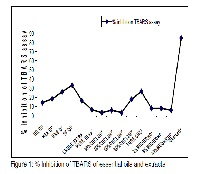First in vitro lipid peroxidation and in vivo anti-inflammatory activity of the Omani frankincense of Boswellia sacra Flueck.
Keywords:
Frankincense, Essential oil, Boswellia sacra, Anti-inflammatory activity, Lipid peroxidationAbstract
The use of frankincense for the medicinal and religious purposes dates back to the early Egyptians, the Greeks, and the Chinese and today, it is commonly used as an anti-inflammatory, antiseptic, anti-tumor, sedative and diuretic agent. To prove the scientific basis of the anti-inflammatory properties and the in vitro lipid peroxidation of the Omani Frakincense on pharmacological grounds, the present study was conducted. The crude extract, the essential oils and various sub-fractions of the crude methanolic extract (300 mg/kg of the body weight of the animals) obtained from the resin of Boswellia sacra Flueck. were evaluated for their in vivo anti-inflammatory activities using carrageenan-induced hind paw edema in rats and in vitro lipid peroxidation by using the thiobarbituric acid reactive substance (TBARS) assay. The tremendous folk use of frankincense as an anti-inflammatory agent was rationalized by our present study of the in vitro TBARS assay and the in vivo anti-inflammatory activities. To the best of our knowledge, this is the first report of the anti-inflammatory activity studies which has been conducted thoroughly on the essential oils, the crude extract and the various sub-fractions obtained by using various polarity organic solvents on the resin of the plant Boswellia sacra Flueck.
References
Das BN, Saha A, Ahmed M. Anti-inflammatory activity of bark of Xeromphis spinosa. Bangladesh J Pharmacol. 2009;4:76–78.
Kumar V, Abbas AK, Fausto N. In: Robbins and Cotran pathologic basis of disease. 7th ed. Philadelphia, Elsevier, Saunders; 2004. p. 47–86.
Wen CL, Chang CC, Huang SS, Kuo CL, Hsu SL, Deng JS, Huang GJ. Anti-inflammatory effects of methanol extract of Antrodia cinnamomea mycelia both in vitro and in vivo. J Ethnopharmacol. 2011;137:575–584.
Kang HS, Lee JY, Kim CJ. Anti-inflammatory activity of arctigenin from Forsythiae fructus. J Ethnopharmacol. 2008;116:305–312.
Cui XY, Kim JH, Zhao X, Chen BQ, Lee BC, Pyo HB, Yun YP, Zhang YH. Antioxidative and acute anti-inflammatory effects of Campsis grandiflora flower. J Ethnopharmacol. 2006;103:223–228.
Sosa S, Balick MJ, Arvigo R, Esposito RG, Pizza C, Altinier G, Tubaro A. Screening of the topical anti-inflammatory activity of some Central American plants. J Ethanopharmacol. 2002;81:211–215.
Mattison N, Trimple AG, Lasagna I. New drug development in the United States, 1963 through 1984. Clin Pharmacol Ther. 1998;43:290–301.
Thomas MK, Narang D, Lakshmy R, Gupta R, Naik N, Maulik SK. Correlation between inflammation and oxidative stress in normocholesterolemic coronary artery disease patients “on” and “off” atorvastatin for short time intervals. Cardiovasc Drugs Ther. 2006;20:37–44.
Coppi A, Cecch L, Selvi F, Raffaell M. The frankincense tree (Boswellia sacra, Burseraceae) from Oman: ITS and ISSR analyses of genetic diversity and implications for conservation. Gen Res Crop Evol. 2010;57:1041–1052.
Al-Harrasi A, Al-Saidi, S. Phytochemical analysis of the essential oil from botanically certified oleogum resin of Boswellia sacra (Omani Luban). Molecules. 2008;13:2181-2189.
Mertens, M, Buettner A, Kirchhof E. The volatile constituents of frankincense: a review. Flavour Fragr J. 2009;24:279–300.
Singh GB, Atal CK. Pharmacology of an extract of Salai guggal ex-Boswellia serrata, a new non steroidal anti-inflammatory agent. Agents Actions. 1986;18:407–412.
Shah BA, Nabi QG, Taneja SC. Boswellic acids: A group of medicinally important compounds. Nat Prod Rep. 2009;26:72-89.
Safayhi H, Mack T, Sabieraj J, Anazodo MI, Subramanian LR Ammon HP. Boswellic acids: Novel specific nonredox inhibitors of 5-lipoxygenase. J Pharmacol Exp Therapeutics. 1992;261:1143–1146.
Safayhi H, Sailer ER. Anti-inflammatory actions of pentacyclic triterpenes. Planta Med. 1997;63:487–493.
Neto AG, Costa JM, Belati CC, Vinholis AH, Possebom LS, Da Silva Filho AA, Cunha WR, Carvalho JC, Bastos JK, Silva ML. Analgesic and anti-inflammatory activity of a crude root extract of Pfaffia glomerata (Spreng) Pedersen. J. Ethnopharmacol. 2005;96:87–91.
Van Vuuren SF, Kamatou GPP, Viljoen AM. Volatile composition and antimicrobial activity of twenty commercial frankincense essential oil samples. Afr J Bot. 2010;76:686–691.
AOAC International (Association of Official Analytical Communities). Official methods of analysis of AOAC International 17th ed. Gaithersberg, USA, 2003.
Chang ML, Yeh CT, Lin DY, Ho YP, Hsu CM, Bissell DM. Hepatic inflammation mediated by hepatitis C virus core protein is ameliorated by blocking complement activation. BMC Med Genomics. 2009;2:51.
Winter CA, Risley EA, Nuss GV. Carrageenin-induced edema in hind paw of the rat as an assay for anti-inflammatory drugs. Exp Biol Med. 1962;111:544–547.
Ferreira SH, Lorenzetti BB, Castro MSA, Correa FMA. Anti-algic effect of aspirin-like drugs and the inhibition of prostaglandin synthesis. In: Dumonde DC, Jasani MK, editors. The Recognition of Anti-rheumatic Drugs. St. Leonard House, Lancaster: MTP Press Ltd.; 1978. p. 25–37.
Buege JA, Aust SD. Microsomal lipid peroxidation. Methods Enzymol. 1978;52:302‒310.
Alcaraz MJ, Jimenez MJ. Anti-inflammatory compounds from sideritis javalambrensis n-hexane extract. J Nat Prod. 1989;52:1088‒1091.
Salvemini D, Misko TP, Masferrer JL, Seibert K, Currie MG, Needleman P. Nitric oxide activates cyclooxygenase enzymes. Proc. Natl. Acad. Sci. USA. 1993;90:7240–7244.
Spector WG. The inflammatoryresponse. J Pathol Bacterial. 1960;84:391–403.
Ueno A, Naraba H, Ikeda, Y, Ushikubi, F, Murata, T, Naramiya S, Ohishi S. Intrinsic prostacyclin contributes to exudation induced by bradikinin or carrageenan: A study on the paw edemainduced in ip-receptor-deficient mice. Life Science. 2000;66:155–160.
Hseu YC, Wu FY, Wu JJ, Chen JY, Chang WH, Lu FJ. Antiinflammatory potential of Antrodia camphorata through inhibition of iNOS, COX-2 and cytokines via the NF-kB pathway. Int. Immunopharmacology. 2005;5:1914–1925.



